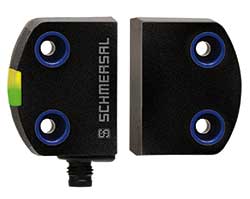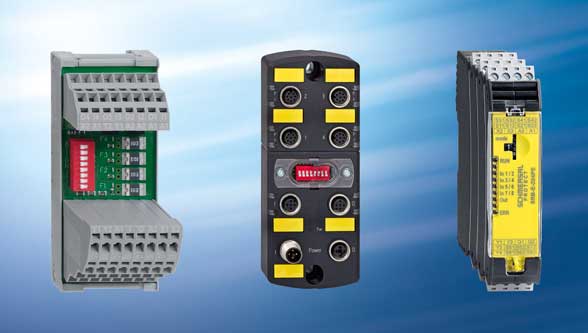Digitisation in industrial production imposes new requirements on machine safety. It also lays the foundations for new solutions. This article looks at the effects of Industry 4.0 on functional machine safety.
Keywords: Machine Safety, Digitisation, Internet of things, Platform Economy, Industry 4.0.
The Schmersal Group develops and produces some 25,000 switchgear units, making it one of the largest providers anywhere in the world. Motivated by a vision of a safe world of work, the company’s development engineers are constantly working on new devices and systems for all conceivable application situations. Development focuses on three areas lift technology, automation technology and safety technology and has produced a range of mechanical and non-contact switchgear devices, a portfolio of safety switchgear and safety switching systems for protection of man and machine. Digitisation, the internet of things, platform economy, Industry 4.0. Behind all of these buzzwords is a real ‘mega trend’ that is sweeping through industry. Virtually every company has been touched by this mega trend, and we’re likely to see significant changes in every stage of industrial production as a result.This also affects machine safety, and in a multitude of ways. In the first instance, new machines and production concepts impact the design of safety systems. If components are manufactured in highly-automated one-size production batches, machines need to offer much greater flexibility, as too must the safety equipment. The most striking example of this are collaborating robots, which operate alongside workers without safety fences to separate them. Secondly, the unbroken networked communication systems of Production 4.0 offer new opportunities for machine safety. Infrastructure like the cloud and edge computing and, at product level, virtual machine and system twins, help to enhance the transparency and flexibility of safety equipment. We will outline some examples of both trends below.

Increasing productivity as a goal
It is a principle that machine safety should not be allowed to impair the productivity of a machine. This is far from a new requirement, but in the age of Industry 4.0, it has become far more pressing. In response to this, increasing numbers of machine builders are seeking cooperation from machine safety experts early on in the design of new series, with the aim of integrating safety functions into machine functions in such a way that productivity is maximised alongside high levels of safety. New tools such as multi-discipline Systems Engineering are available to assist with this challenge. When it comes to machine safety, qualified services are available and offered by Schmersal under the tec.nicum brand. Services include design support, encompassing machine safety aspects and customer-specific programming of safety control units. Both help to ensure that safety functions can be integrated into or coordinated with operational machine functions as seamlessly as possible, so as not to impair productivity.
Systems and solutions for machine safety
In today’s world, machine builders can benefit greatly by procuring safety systems from a single source. As a systems and solutions provider for machine safety, Schmersal offers safety components and systems for signal evaluation alongside consultancy, project planning and engineering services.In view of the increasing complexity of machines, machine control units and safety systems, it is vital that we offer complete solutions packages. Individual components such as RFID-based security sensors have already been developed, like the RSS260, which can also transmit diagnostics information such as error messages, e.g. ‘Fault or short circuit at a safety output’ or ‘Faulty actuator’, to enable rapid elimination of errors. In addition, these advanced diagnostics functions also enable predictive maintenance and the avoidance of machine downtime by transmitting non-safety-related status information to operating control units, such as a notification to adjust the safety door in the event of a door offset. The extended features of these RFID sensors, such as the RSS260, also include individual encoding for enhanced manipulation protection.

Data exchange beyond the machine
Things become even more complex when you go beyond component level to control unit level. The goal here is to collate and evaluate the data generated by safety switchgear, a task accomplished with help of safety-oriented bus systems such as ASi Safety at Work. If necessary, decentralised concepts can also be realised, such as on machines built as modular systems. In that case, field boxes and safety installation systems from Schmersal may be used to help create the conditions for quick and easy series connection of safety switchgear units and for the integration of different and mixed switch types, such as safety interlocks and safety systems. This also allows non safety-related diagnostics signals to be transmitted to a standard PLC via common field bus interfaces, such as ProfiNet or Ethernet IP.
From the safety door to the cloud
The new Smart Safety Solution even allows diagnostics information to be transmitted to the cloud via the Protect PSC1 safety control unit or the SD gateway and an edge gateway for the capture of data such as limit and distance warnings and operating status information from safety equipment. There is, therefore, unbroken communication over the entire automation pyramid. Diagnostics information can then be displayed on screens and retrieved on devices such as tablets and smartphones, allowing for remote monitoring of production processes and predictive maintenance. Common cloud platforms, such as Microsoft Azure, are used to allow data to be displayed via dashboards. In this case too, new-generation safety control units take on management of increasing complexity in the safety circuit, with the modular PSC1 safety control unit capable of evaluating data from various production cells. As such, multiple robot cells are able to communicate with one another and exchange safety-related data and error messages. With this capability, machine builders can now determine which data to transmit. In the medium term, products produced on the machines will also be integrated into the data stream as they carry with them the relevant data like ‘virtual twins’ a fundamental element of Industry 4.0. With the cloud-based Smart Safety Solution, Schmersal has already created the conditions for this and other similar concepts.
Good communication skills required
These examples demonstrate how the ability of components to communicate is central to the exchange of data over different levels. Flexibility is equally important. As such, the PSC1 allows the safety functions of machines to be modified to different applications within each modular principle. Core components are freely programmable compact control units (PSC1-C-10/100) with I/O expansion modules available for secure signal processing from different safety switches. A universal communication interface allows the user to make simple software-based selections and adjustments of different field bus protocols. The same hardware also allows connection to all common field bus systems (PROFINET, PROFINET PROFIsafe, EtherCAT, EtherCATFSOE, Profibus, Profibus ProfiSafe and Ethernet IP). The new opportunities offered by digitisation are also changing the way in which designers, who are responsible for selecting the safety systems, work. At Motek 2018, Schmersal will be unveiling an online planning tool that has been designed to enable quick and easy configuration of the modular PSC1 safety control unit. The PSC1 configurator is an online tool with 24/7 availability. It is both intuitive and easy to operate and offers designers a robust planning foundation in just a few minutes. The planning tool automatically selects the optimal PSC1 safety control unit based on a selection of safety sensors and safety outputs and indicates the space that will be occupied by the assembly configuration on the profile rail. At the same time, the PSC1 configurator also generates a bill of materials including item names, material numbers and details of devices. This bill of materials is linked to Schmersal’s online catalogue, allowing the user to look up device information as required. The bill of materials can be exported in Excel or PDF format for direct e-mail attachment and subsequent quotation.

Interplay between man and robot
And finally a look at the supreme discipline of machine safety the interplay between man and robot in a shared workspace, with no safety fences to separate them. Something that can only be achieved with a safety-related control unit that has been configured to ensure that robots never leaves their work zones and never exceed defined axle speeds. The Schmersal Group offers robot manufacturers the functionality of a safety-related control unit for human/robot cooperation in the form of its Safety Controller product. Sensor systems are essential whenever there is direct contact between man and robot, so that collisions can be detected, and robot movements stopped promptly. Work is being conducted in close cooperation with the Bonn-Rhein-Sieg University of Applied Sciences to develop a technically feasible and economically efficient safety solution to address precisely this problem. This and the other examples outlined above demonstrate that machine safety can help to realise Industry 4.0 concepts while also harmonising occupational safety and productivity in innovative and complex integrated systems.
![]()
Author: Christian Heller, Head of Sales for Central Germany, Schmersal Group
www.schmersal.com



